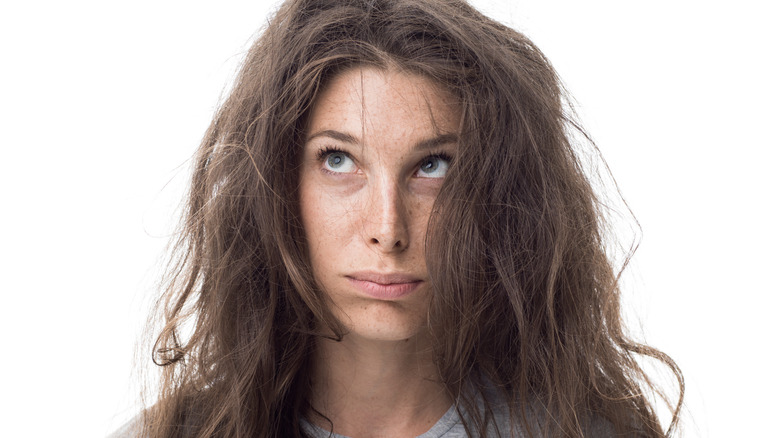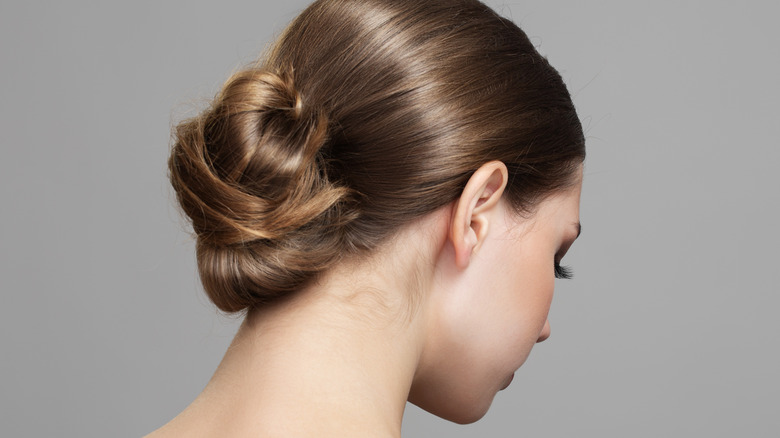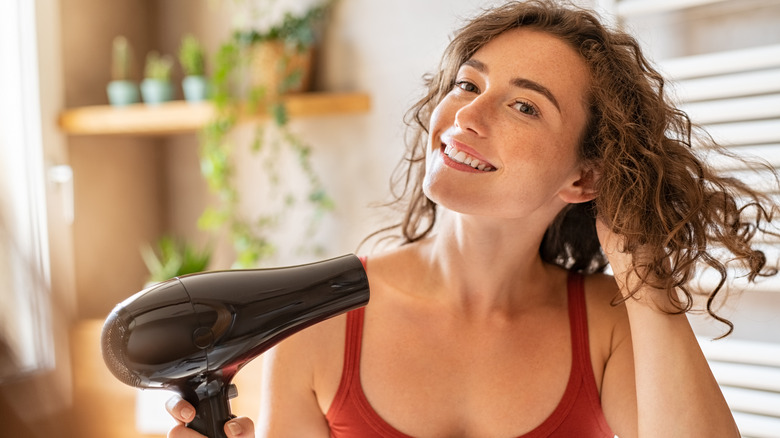Yes, You Can Get Mildew In Your Hair - Here's How To Avoid It
When you think about mildew, you probably think of moldy bathrooms, build-up, or nasty residue. Normally, mildew is not associated with hair, but in case you didn't know: yes, your hair can get mildew. Fret not, though, because mildew isn't necessarily the same mold you've seen growing in gnarly bathrooms. Mildew refers only to certain kinds of molds and fungi, while mold includes all species of microscopic fungi (via the U.S. Environmental Protection Agency).
When it comes to hair mildew, it is important to think about the role your scalp plays in its cleanliness. Oftentimes, many people focus on only cleaning the hair but not their scalp. Mildew in hair happens when wet hair does not get a chance to fully dry. When the moisture gets trapped, it breeds mildew or fungus on the surface of the scalp. Often, those with curly, locked, or wavy hair are more prone to it. Additionally, if you sweat a lot, or often wear hairdos like buns, ponytails, or up-dos, your hair is also at risk (via Naturally Curly). Still, there are ways to avoid experiencing this.
What is hair mildew?
According to Healthline, the mildew that forms in hair is a fungus known as yeast. It can grow on the scalp and cause hair loss or dandruff, and some of it can even grow directly on your hair. With the presence of yeast comes the risk of yeast overgrowth, and, therefore, the possibility of a yeast infection on the scalp. Some of these infections may appear as hair ringworm (which is not actually a worm), black growths, white growths, or seborrheic dermatitis, leading to skin patches or stubborn dandruff.
Not only is hair mildew a problem for your hair and scalp simply because of its presence but also because it can affect your hair's health. "Being the environment from which hair grows, scalp health is vital for healthy hair. In fact, studies have proven that a flaky scalp can cause and/or worsen hair loss," trichologist Anabel Kingsley tells New Beauty. "Plus, if the scalp is in bad condition, the hair is likely to be dull and limp."
How to avoid mildew in your hair
Like everything else on your body, how you approach the health of your hair matters. There are many aspects to consider when trying to avoid hair mildew. According to New Beauty, wet hair tends to be in a sensitive state. If it remains wet, it creates the most ideal environment for fungus growth, and how you treat it while wet can add another layer of damage. Combining both mildew and other types of damage is never good for your hair.
"Water in hair does not come without some risk of damage, and the wetter the hair, the more the risk. Depending on the type and health of hair, that risk varies," founder and creator of hair product businesses Aquis and K18 Hair Britta Cox tells New Beauty. "If the hydrogen bonds are exposed to water for too long, they break and hair can plasticize. It gets mushy from the inside and becomes stretchy, which weakens it and can lead to split ends and breakage."
Avoiding mildew also means avoiding infection, especially when yeast is involved. Healthline recommends drying your hair as much as possible when wet. Avoid going to bed with wet hair, and washing — and then drying — after sweating. Dealing with hair fungus is usually manageable at home, especially if you're taking the proper preventative measures. However, if you suspect an infection, speak with a doctor to properly diagnose and guide you through necessary treatment.


